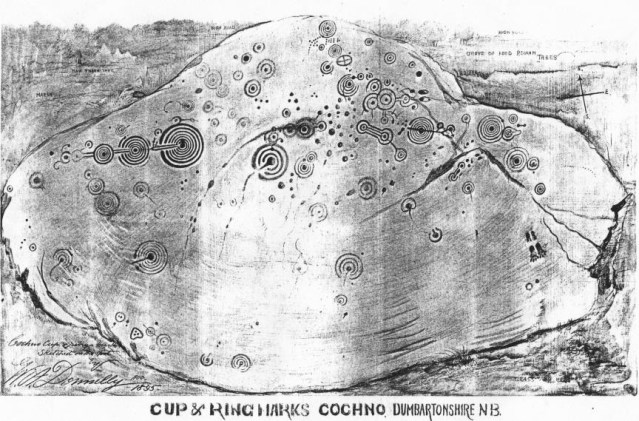Scotland’s archives, local and national, contain a treasure trove of material a lot of which is an untapped resource for future research and projects.
The Orkney News recently highlighted the wonderful ‘This is time travel’ in a ‘Sea of Voices’ which delved into the recordings in the Orkney Library and Archives sound room.
Kilmartin Museum have been producing excellent online talks and if you have never watched one please do, they are free and cover a diverse range of topics.
The latest talk was exploring Rock Art in Scotland and specifically at Cochno, Faifley, West Dunbartonshire and Kilmartin, Argyll. Dr Kenneth Brophy of Glasgow University, aka The Urban Prehistorian, has been delving into the archival collections of Ronald Morris and Ludovic MacLellan Mann. Both of these men were ‘amateur’ archaeologists but they produced invaluable research and the recording of rock art in Scotland.
The Cochno Stone

The Cochno Stone is a massive piece of extraordinary rock art in Dunbartonshire, measuring 42 by 26 feet (12.8 by 7.9 metres). It was buried in 1965, because people had been marking it, carving their names into it, and in the case of Ludovic Mann, painting on it. It was uncovered in 2015 by Kenneth Brophy which you can read about here: The Cochno Stone exposed
Dr Brophy has been looking into the archival material collected about The Cochno Stone and his extensive searches have now revealed images of the stone which were not known about. The Stone has over 100 prehistoric symbols carved into it. In 1937 Mann, using oil paints, traced the outline of these symbols but he also added in lines of his own and other markings. When the stone was briefly uncovered in 2015 evidence of those paint lines could still be seen round the edges where vegetation had covered them over. It is hoped that in the future this remarkable stone will again be able to be seen by the public, perhaps in a built structure where it can be protected.
Kilmartin Glen

Located between Oban and Lochgilphead, Kilmartin Glen has one of the most important concentrations of Neolithic and Bronze Age remains in Scotland. The Orkney News has featured articles about Kilmartin Glen by Bernie Bell: A Different Kind Of Rock Art – Part Three; ‘Cup’ Marks – Past and Present; Bernie Bell: Bernie & Mike’s Road Trip – Spring 2017 and many more.
Ronald Morris recorded over 400 rock art sites in Scotland and published some of his material. Dr Brophy has been accessing Morris’ meticulously written records which are kept by Historic Environment Scotland. Morris’ notes, photographs and other records, have not been digitised, and they contain a wealth of material. Morris did not use paint on these wonderful rock art monuments but chalk which he could then photograph. He also took rubbings of the markings. This amazing resource is where future study could take place, possibly allowing the location of rock art stones being rediscovered.
If you want to find out more about Scotland’s Rock Art click on this link: Scotland’s Rock Art Project
Click on this link for information about: Kilmartin Museum
This talk was recorded and will be available soon on YouTube. Visit: Kilmartin Museum










Fiona Grahame
Categories: Uncategorized
















As teenagers Andrew Murray and I acted as guide to R W B Morris showing him cup and ring or some just cup marked stones in the Kilfinan area in Argyll, the three of us sharing a two seater white open top sports car as we flew around the area. One stone we visited at Inveryne would certainly rival the Cochno stone for extent and complexity. Stranger still our mothers (sisters) played on the Cochno stone as children living at Hardgate. Stranger still one of the ladies we met through our family interest in archaeology and pre-history, the late Dorothy Nairn Marshall, pointed me as a student in the direction that led to my professional involvement in the veterinary practice on the Isle of Bute from 1971 to the present day.
A Song in Stone…
https://theorkneynews.scot/2021/06/28/a-song-in-stone/